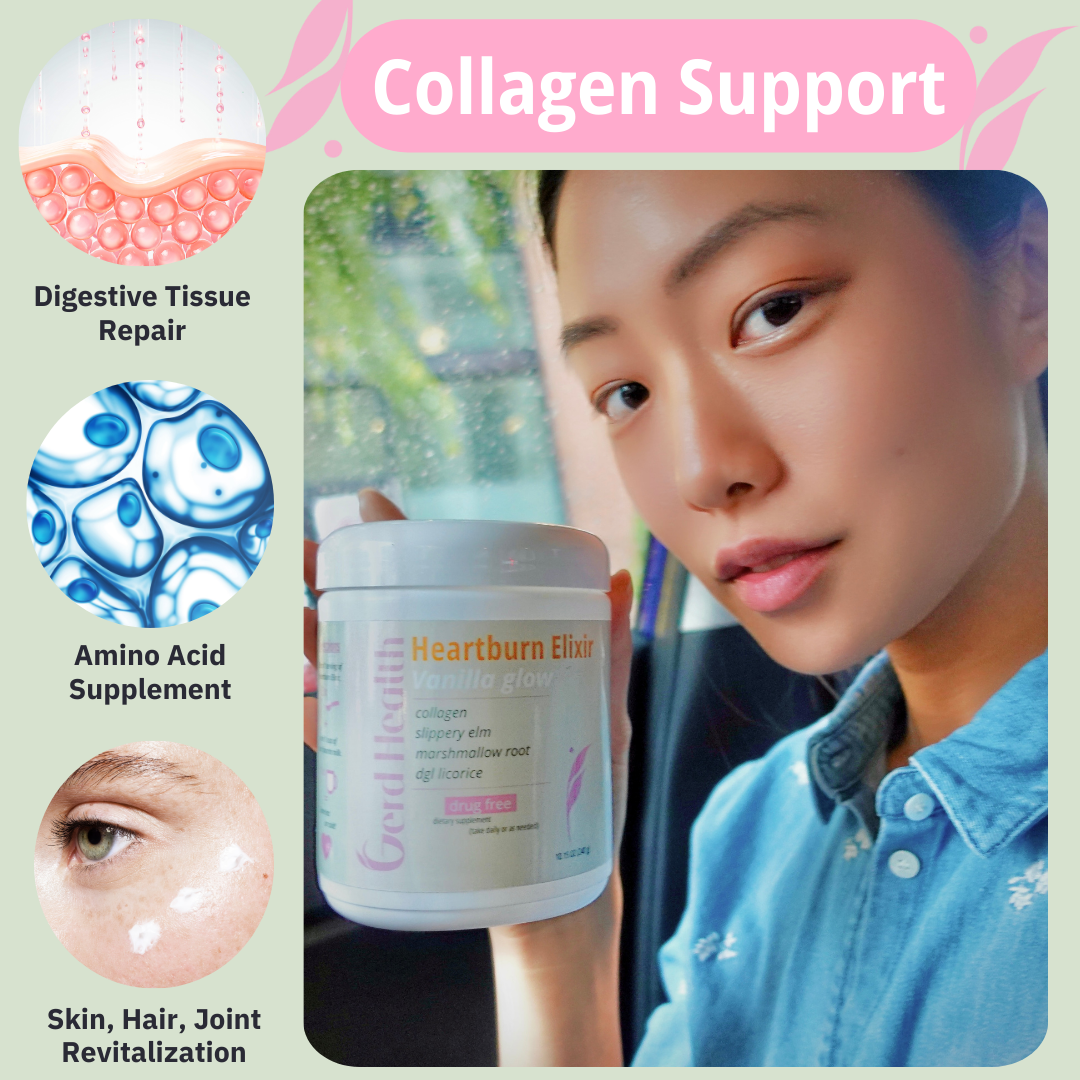Heartburn Elixir: Vanilla Glow
Heartburn Elixir: Vanilla Glow
Heartburn Elixir: A tasty drink mix crafted with premium botanicals, proven to effectively relieve heartburn.
6 Holistic Ingredients: collagen, slippery elm bark, marshmallow root, DGL licorice root, monk fruit & water-extracted vanilla.
Flavor Profile: A creamy and smooth texture paired with the delicate floral essence of premium water-extracted vanilla.
Featured Ingredient: Our bovine collagen is from grass-fed & pasture raised cattle. It contains amino acids like glycine and proline, which restore gut wall integrity.
Our Advantage:
- Quickly alleviates active heartburn.
- Coats/Protects the esophagus with plant mucilage.
- Strengthens the gut barrier.
- Enhances digestion/nutrient absorption.
- Boosts elasticity, hydration & firmness of the skin.
Couldn't load pickup availability







GERD Health vs Other Antacids
GERD Health
PPIs
Tums
100% Natural Ingredients
No Side Effects
Delicious
Instant & Lasting Relief
Supports Gut Health
Kills Bad Bacteria
Found in Nature, Backed by Science.

Stimulates tissue regeneration, promotes healing.
- Deters, A., Zippel, J., Hellenbrand, N., Pappai, D., Possemeyer, C., & Hensel, A. (2010). Aqueous extracts and polysaccharides from marshmallow roots (Althea officinalis L.): Cellular internalisation and stimulation of cell physiology of human epithelial cells in vitro. Journal of Ethnopharmacology, 127(1), 62–69.
https://doi.org/10.1016/j.jep.2009.09.050
- Fink, C., Schmidt, M., & Kraft, K. (2018). Marshmallow root extract for the treatment of irritative cough: Two surveys on users’ view on effectiveness and tolerability. Complementary Medicine Research, 25(5), 299–305.
https://doi.org/10.1159/000489560
- Elmastas, M., Ozturk, L., Gokce, I., Erenler, R., & Aboul‐Enein, H. Y. (2004). Determination of antioxidant activity of marshmallow flower (althaea officinalisL.). Analytical Letters, 37(9), 1859–1869.
https://doi.org/10.1081/al-120039431
- Hage-Sleiman, R., Mroueh, M., & Daher, C. F. (2011). Pharmacological evaluation of aqueous extract ofalthaea officinalisflower grown in Lebanon. Pharmaceutical Biology, 49(3), 327–333.
https://doi.org/10.3109/13880209.2010.516754
- Bonaterra, G. A., Bronischewski, K., Hunold, P., Schwarzbach, H., Heinrich, E.-U., Fink, C., Aziz-Kalbhenn, H., Müller, J., & Kinscherf, R. (2020). Anti-inflammatory and anti-oxidative effects of Phytohustil® and root extract of Althaea officinalis L. on macrophages in vitro. Frontiers in Pharmacology, 11.
https://doi.org/10.3389/fphar.2020.00290
- Haghgoo R, Mehran M, Afshari E, Zadeh HF, Ahmadvand M. Antibacterial Effects of Different Concentrations of Althaea officinalis Root Extract versus 0.2% Chlorhexidine and Penicillin on Streptococcus mutans and Lactobacillus (In vitro). J Int Soc Prev Community Dent. 2017 Jul-Aug;7(4):180-185. doi: 10.4103/jispcd.JISPCD_150_17. Epub 2017 Jul 31. PMID: 28852633; PMCID: PMC5558251.
https://pubmed.ncbi.nlm.nih.gov/28852633/
- Skrinjar, I., Vucicevic Boras, V., Bakale, I. et al. Comparison between three different saliva substitutes in patients with hyposalivation. Clin Oral Invest 19, 753–757 (2015).
https://doi.org/10.1007/s00784-015-1405-8
- Rezaei M, Dadgar Z, Noori-Zadeh A, Mesbah-Namin SA, Pakzad I, Davodian E. Evaluation of the antibacterial activity of the Althaea officinalis L. leaf extract and its wound healing potency in the rat model of excision wound creation. Avicenna J Phytomed. 2015 Mar-Apr;5(2):105-12. PMID: 25949951; PMCID: PMC4418059.
Coats and soothes the esophagus, prevents ulcer formation.
- Hawrelak, J. A., & Myers, S. P. (2010). Effects of two natural medicine formulations on irritable bowel syndrome symptoms: A pilot study. The Journal of Alternative and Complementary Medicine, 16(10), 1065–1071.
https://doi.org/10.1089/acm.2009.0090
- Langmead, L., Dawson, C., Hawkins, C., Banna, N., Loo, S., & Rampton, D. S. (2002). Antioxidant effects of herbal therapies used by patients with inflammatory bowel disease: An in vitro study. Alimentary Pharmacology & Therapeutics, 16(2), 197–205.
https://doi.org/10.1046/j.1365-2036.2002.01157.x
- Shahrajabian, M. H., Sun, W., & Cheng, Q. (2020). Traditional Herbal Medicine for the prevention and treatment of cold and flu in the autumn of 2020, overlapped with covid-19. Natural Product Communications, 15(8).
https://doi.org/10.1177/1934578x20951431
- Watts, Christopher & Rousseau, Bernard. (2012). Slippery Elm, its Biochemistry, and use as a Complementary and Alternative Treatment for Laryngeal Irritation. Journal of Investigational Biochemistry. 1. 17-23. 10.5455/jib.20120417052415.
- Setright, R. (2017) ‘Prevention of symptoms of gastric irritation (GERD) using two herbal formulas: An observational study’, Journal of the Australian Traditional-Medicine Society. Meadowbank, NSW: Australian Traditional-Medicine Society, 23(2), pp. 68–71.
https://search.informit.org/doi/10.3316/informit.950298610899394.
Supports gastric mucosal barrier & inhibits bacterial infections.
- Park, J., Jang, D., Phung, H.M.et al.The potential of pharmacological activities of the multi-compound treatment for GERD: literature review and a network pharmacology-based analysis.Appl Biol Chem64, 48 (2021).
https://doi.org/10.1186/s13765-021-00617-2
- Mendonça MAA, Ribeiro ARS, Lima AK, Bezerra GB, Pinheiro MS, Albuquerque-Júnior RLC, Gomes MZ, Padilha FF, Thomazzi SM, Novellino E, Santini A, Severino P, B Souto E, Cardoso JC. Red Propolis and Its Dyslipidemic Regulator Formononetin: Evaluation of Antioxidant Activity and Gastroprotective Effects in Rat Model of Gastric Ulcer. Nutrients. 2020 Sep 26;12(10):2951. doi: 10.3390/nu12102951. PMID: 32993069; PMCID: PMC7600383.
https://www.mdpi.com/2072-6643/12/10/2951
- Rahnama M, Mehrabani D, Japoni S, Edjtehadi M, Saberi Firoozi M. The healing effect of licorice (Glycyrrhiza glabra) on Helicobacter pylori infected peptic ulcers. J Res Med Sci. 2013 Jun;18(6):532-3. PMID: 24250708; PMCID: PMC3818629.
https://www.ncbi.nlm.nih.gov/pmc/articles/PMC3818629/
- Ghalayani, P., Emami, H., Pakravan, F. and Nasr Isfahani, M. (2017), Comparing triamcinolone with licorice. Asia-Pac J Clin Oncol, 13: e48-e56.
https://doi.org/10.1111/ajco.12295
- Schulz RM, Ahuja NK, Slavin JL. Effectiveness of Nutritional Ingredients on Upper Gastrointestinal Conditions and Symptoms: A Narrative Review. Nutrients. 2022; 14(3):672.
https://doi.org/10.3390/nu14030672
- Yeh AM, Golianu B. Integrative Treatment of Reflux and Functional Dyspepsia in Children. Children. 2014; 1(2):119-133.
https://doi.org/10.3390/children1020119
- Jalilzadeh-Amin G, Najarnezhad V, Anassori E, Mostafavi M, Keshipour H. Antiulcer properties of Glycyrrhiza glabra L. extract on experimental models of gastric ulcer in mice. Iran J Pharm Res. 2015 Fall;14(4):1163-70. PMID: 26664383; PMCID: PMC4673944.
https://pubmed.ncbi.nlm.nih.gov/26664383/
- Kumagai A., Nanaboshi M., Asanuma Y., et al. Effects of glycyrrhizin on thymolytic and immunosuppressive action of cortisone. Endocrinol Jpn. 1967;14:39–42.
https://pubmed.ncbi.nlm.nih.gov/6072412/
- Pompei, R., Pani, A., Flore, O. et al. Antiviral activity of glycyrrhizic acid. Experientia 36, 304 (1980).
https://doi.org/10.1007/BF01952290
- Zhi Y. Wang & Daniel W. Nixon (2001) Licorice and Cancer, Nutrition and Cancer, 39:1, 1-11,
- Murray MT. Glycyrrhiza glabra (Licorice). Textbook of Natural Medicine. 2020:641–647.e3. doi: 10.1016/B978-0-323-43044-9.00085-6. Epub 2020 Jul 10. PMCID: PMC7348626.
https://www.ncbi.nlm.nih.gov/pmc/articles/PMC7348626/
- Han, S., Sun, L., He, F. et al. Anti-allergic activity of glycyrrhizic acid on IgE-mediated allergic reaction by regulation of allergy-related immune cells. Sci Rep 7, 7222 (2017).
Alleviates nausea & reduces bloating.
- Zick, S. M., Turgeon, D. K., Vareed, S. K., Ruffin, M. T., Litzinger, A. J., Wright, B. D., Alrawi, S., Normolle, D. P., Djuric, Z., & Brenner, D. E. (2011). Phase II study of the effects of ginger root extract on eicosanoids in colon mucosa in people at normal risk for colorectal cancer. Cancer Prevention Research, 4(11), 1929–1937.
https://doi.org/10.1158/1940-6207.capr-11-0224
- Nikkhah Bodagh, M., Maleki, I., & Hekmatdoost, A. (2018). Ginger in gastrointestinal disorders: A systematic review of Clinical Trials. Food Science & Nutrition, 7(1), 96–108.
https://doi.org/10.1002/fsn3.807
- Anh, N. H., Kim, S. J., Long, N. P., Min, J. E., Yoon, Y. C., Lee, E. G., Kim, M., Kim, T. J., Yang, Y. Y., Son, E. Y., Yoon, S. J., Diem, N. C., Kim, H. M., & Kwon, S. W. (2020). Ginger on human health: A comprehensive systematic review of 109 randomized controlled trials. Nutrients, 12(1), 157.
https://doi.org/10.3390/nu12010157
- Makhdoomi Arzati, M., Mohammadzadeh Honarvar, N., Saedisomeolia, A., Anvari, S., Effatpanah, M., Makhdoomi Arzati, R., Yekaninejad, M. S., Hashemi, R., & Djalali, M. (2017). The effects of ginger on fasting blood sugar, hemoglobin a1c, and lipid profiles in patients with type 2 diabetes. International Journal of Endocrinology and Metabolism, In Press(In Press).
https://doi.org/10.5812/ijem.57927
- Arablou, T., Aryaeian, N., Valizadeh, M., Sharifi, F., Hosseini, A., & Djalali, M. (2014). The effect of ginger consumption on glycemic status, lipid profile and some inflammatory markers in patients with type 2 diabetes mellitus. International Journal of Food Sciences and Nutrition, 65(4), 515–520.
https://doi.org/10.3109/09637486.2014.880671
- Prasad, S., & Tyagi, A. K. (2015). Ginger and its constituents: Role in prevention and treatment of gastrointestinal cancer. Gastroenterology Research and Practice, 2015, 1–11.
https://doi.org/10.1155/2015/142979
- Ha, S. K., Moon, E., Ju, M. S., Kim, D. H., Ryu, J. H., Oh, M. S., & Kim, S. Y. (2012). 6-shogaol, a ginger product, modulates neuroinflammation: A new approach to neuroprotection. Neuropharmacology, 63(2), 211–223.
https://doi.org/10.1016/j.neuropharm.2012.03.016
- Masuda, Y., Kikuzaki, H., Hisamoto, M., & Nakatani, N. (2004). Antioxidant properties of gingerol related compounds from ginger. BioFactors, 21(1–4), 293–296.
https://doi.org/10.1002/biof.552210157
- F., B. I. F., & Wachtel-Galor, S. (2011). Chapter 7: The Amazing and Mighty Ginger. In Herbal medicine: Biomolecular and clinical aspects (2nd ed.). essay, CRC Press.
https://www.ncbi.nlm.nih.gov/books/NBK92775/
- Lohsiriwat, S. , Rukkiat, M. , Chaikomin, R. , & Leelakusolvong, S. (2010). Effect of ginger on lower esophageal sphincter pressure. Medical Journal of the Medical Association of Thailand, 93(3), 366. - PubMed
https://pubmed.ncbi.nlm.nih.gov/20420113/
- Dugasani, S., Pichika, M. R., Nadarajah, V. D., Balijepalli, M. K., Tandra, S., & Korlakunta, J. N. (2010). Comparative antioxidant and anti-inflammatory effects of -gingerol, -gingerol, -gingerol and -shogaol. Journal of Ethnopharmacology, 127(2), 515–520.
The featured ingredient in Luxe Carob!
Aids metabolic health, regulates blood sugar.
- Gioxari A, Amerikanou C, Nestoridi I, Gourgari E, Pratsinis H, Kalogeropoulos N, Andrikopoulos NK, Kaliora AC. Carob: A Sustainable Opportunity for Metabolic Health. Foods. 2022; 11(14):2154.
https://doi.org/10.3390/foods11142154
- Goulas V, Stylos E, Chatziathanasiadou MV, Mavromoustakos T, Tzakos AG. Functional Components of Carob Fruit: Linking the Chemical and Biological Space. International Journal of Molecular Sciences. 2016; 17(11):1875.
https://doi.org/10.3390/ijms17111875
- Ozdil, K., Kahraman, R., Sahin, A. et al. Bone density in proton pump inhibitors users: a prospective study. Rheumatol Int 33, 2255–2260 (2013).
https://doi.org/10.1007/s00296-013-2709-0
- Papaefstathiou, E, Agapiou, A, Giannopoulos, S, Kokkinofta, R. Nutritional characterization of carobs and traditional carob products. Food Sci Nutr. 2018; 6: 2151–2161.
https://doi.org/10.1002/fsn3.776
- Rtibi K, Jabri MA, Selmi S, Souli A, Sebai H, El-Benna J, Amri M, Marzouki L. Gastroprotective effect of carob (Ceratonia siliqua L.) against ethanol-induced oxidative stress in rat. BMC Complement Altern Med. 2015 Aug 20;15:292. doi: 10.1186/s12906-015-0819-9. PMID: 26289579; PMCID: PMC4546091.
Lowers stress levels, promotes gut health.
- Bezerra, D. P., Soares, A. K. & de Sousa, D. P. Therapeutic potential of vanillin and its main metabolites to regulate the inflammatory response and oxidative stress. Mini-Rev. Med. Chem. 19, 1681–1693 (2019).
https://pubmed.ncbi.nlm.nih.gov/30864521/
- Ciciliato MP, de Souza MC, Tarran CM, de Castilho ALT, Vieira AJ, Rozza AL. Anti-Inflammatory Effect of Vanillin Protects the Stomach against Ulcer Formation. Pharmaceutics. 2022; 14(4):755.
https://doi.org/10.3390/pharmaceutics14040755
- Guo J, Han X, Zhan J, You Y, Huang W. Vanillin Alleviates High Fat Diet-Induced Obesity and Improves the Gut Microbiota Composition. Front Microbiol. 2018 Nov 13;9:2733. doi: 10.3389/fmicb.2018.02733. PMID: 30483238; PMCID: PMC6243071.
https://www.ncbi.nlm.nih.gov/pmc/articles/PMC6243071/
- Maisch NA, Bereswill S, Heimesaat MM. Antibacterial effects of vanilla ingredients provide novel treatment options for infections with multidrug-resistant bacteria - A recent literature review. Eur J Microbiol Immunol (Bp). 2022 Sep 23;12(3):53–62. doi: 10.1556/1886.2022.00015. Epub ahead of print. PMID: 36149764; PMCID: PMC9530676.
Reduces Phlegm, 0 Calorie Sweetener.
- Liu C, Dai L, Liu Y, Rong L, Dou D, Sun Y, Ma L. Antiproliferative Activity of Triterpene Glycoside Nutrient from Monk Fruit in Colorectal Cancer and Throat Cancer. Nutrients. 2016; 8(6):360.
https://doi.org/10.3390/nu8060360
- Gu C, Olszewski T, King KL, Vaezi MF, Niswender KD, Silver HJ. The Effects of Modifying Amount and Type of Dietary Carbohydrate on Esophageal Acid Exposure Time and Esophageal Reflux Symptoms: A Randomized Controlled Trial. Am J Gastroenterol. 2022 Oct 1;117(10):1655-1667. doi: 10.14309/ajg.0000000000001889. Epub 2022 Jun 21. PMID: 35973185; PMCID: PMC9531994.
The featured ingredient in Vanilla Glow!
Restores gut wall integrity, balances stomach acid levels.
Abrahams M, O'Grady R, Prawitt J. Effect of a Daily Collagen Peptide Supplement on Digestive Symptoms in Healthy Women: 2-Phase Mixed Methods Study. JMIR Form Res. 2022 May 31;6(5):e36339. doi: 10.2196/36339. PMID: 35639457; PMCID: PMC9198822.
https://www.ncbi.nlm.nih.gov/pmc/articles/PMC9198822/
He F, Wu C, Li P, Li N, Zhang D, Zhu Q, Ren W, Peng Y. Functions and Signaling Pathways of Amino Acids in Intestinal Inflammation. Biomed Res Int. 2018 Feb 26;2018:9171905. doi: 10.1155/2018/9171905. PMID: 29682569; PMCID: PMC5846438.
https://pubmed.ncbi.nlm.nih.gov/29682569/
Gauza-Włodarczyk M, Kubisz L, Włodarczyk D. Amino acid composition in determination of collagen origin and assessment of physical factors effects. Int J Biol Macromol. 2017 Nov;104(Pt A):987-991. doi: 10.1016/j.ijbiomac.2017.07.013. Epub 2017 Jul 4. PMID: 28687386.
Social






















